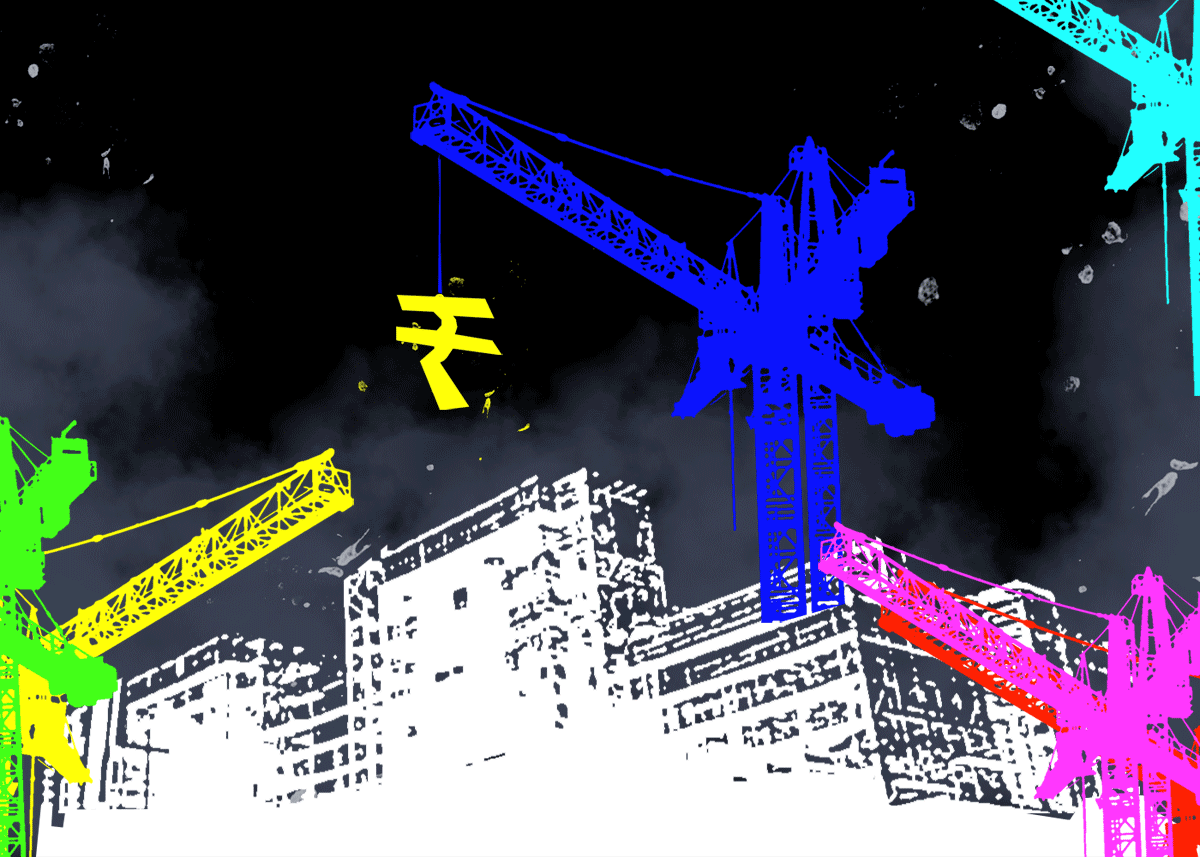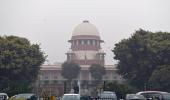'A rigid or overly broad interpretation could lead to a chilling effect on investments and growth in sectors traditionally driven by private initiative.'
'Entrepreneurs may fear that their assets could be arbitrarily appropriated by the State under the guise of serving the 'common good' without sufficient legal safeguards.'
'The judgment thus supports a more nuanced view, one that balances individual property rights with public welfare objectives.'

November 5, 2024, saw a landmark judgment being delivered by the Supreme Court.
A nine-judge Constitution Bench ruled that not all private property can be deemed 'material resource of the community'.
Why this judgment is important can be gauged from the thoughtful and nuanced statements of then Chief Justice Dr D Y Chandrachud in his majority 8:1 judgment.
Justice Chandrachud gave a framework for determining whether a privately owned resource qualifies as a 'material resource of the community' and how to identify key factors for this evaluation.
Dr G V Rao, Senior Advocate, Supreme Court of India and Vice-President, Indian Society of International Law, explains the judgment with precision and detail.
Dr Rao tells Rediff.com Contributor Shobha John that the judgment balances individual property rights with public welfare objectives.
The apex court rejected the expansive view that all resources fall within the purview of the State for redistribution as this could hinder growth in the private sector.
How significant was the November 5, 2024, ruling of the Supreme Court striking down the State's power to seize private property? Can the State take over property if it wants to build a metro or an airport?
The nine-judge Bench of the Supreme Court in Property Owners Association & Ors Vs State of Maharashtra & Ors 2024, marks an important point in Constitutional jurisprudence on property rights in India.
It affirms that private property cannot be arbitrarily taken by the State in the absence of stringent procedural safeguards, as outlined under Article 300A of the Constitution, which although no longer a fundamental right, is a Constitutional and human right.
The judgment emphasises the necessity for the State to fulfill procedural requirements before any such acquisition of private property for public purposes, while giving preponderance to fairness, transparency and just compensation.
However, this judgment in no way prevents the State from acquiring property for essential public projects such as building infrastructure like airports or metros.
For development to continue, the judgment allows for acquisitions, but insists that these be executed through a structured, transparent process that respects individual rights.
It tries to balance private rights with community welfare.

Attorney General R Venkataramani, who appeared for the Union of India, submitted that 'all things in the material world constitute the material resources of the community'. What is your opinion about this?
R Venkataramani's argument is, indeed, a sweeping interpretation of Article 39(b).
He advocated a broad construction, suggesting that there should be no distinction between public and private resources under this provision.
In his words: 'Nothing in Article 39 suggests any limitation of the words used therein.
'The distinction between public and private resources, or natural and human-made resources is alien to the spirit of Article 39(b) and (c).'
He was arguing for an expansive view to support egalitarian goals, contending that narrowly defining 'material resources of the community' would hinder the State's ability to address economic disparities.
However, such a broad interpretation raises concerns.
If, for instance, private assets like a person's home or small business were deemed 'community resources', it would definitely infringe on individual property rights, potentially undermining the right to property enshrined under Article 300A.
While redistribution is a recognised goal under Article 39(b), the Court has also emphasised that procedural safeguards in property law must respect private ownership.
The Court acknowledged the importance of distinguishing between different types of private property and only bringing those that serve a public purpose under State control.
Thus, while Venkataramani's interpretation aligns with socialist ideals, it does risk an overreach, potentially subjecting all private property to redistribution, an approach that the Court has tempered by affirming procedural protections and criteria for what constitutes 'material resources of the community'.
As the Court stated at Para 229: 'The direct question referred to this bench is whether the phrase 'material resources of the community' used in Article 39(b) includes privately owned resources.
'Theoretically, the answer is yes, the phrase may include privately owned resources.
'However, this Court is unable to subscribe to the expansive view adopted in the minority judgment authored by Justice Krishna Iyer in Ranganatha Reddy and subsequently relied on by this Court in Sanjeev Coke.
'Not every resource owned by an individual can be considered a 'material resource of the community' merely because it meets the qualifier of 'material needs'.'
So if one builds a house, it cannot, strictly speaking, be treated as community property, in view of the fact that most judgments on land acquisition hold that private property is property that most citizens have as matter of right under Article 300A which is sacrosanct.
It can be acquired only if the State requires it for 'public purpose' which is urgent and compelling.
Even then, the State is expected to pay the citizen appropriate compensation equivalent to the market price. Hence, only the resources of the State which is other than what is explicitly understood as private property can only be treated as 'community resources'.
At the time of the framing the Constitution, the right to property was a 'Fundamental Right' under Articles 31 and 19 (1), which were removed in 1978 to make it a Constitutional right only and placed as Article 300A and the Directive Principles of State Policy were only guides to the State to harmoniously adopt them without being directly in conflict with the Fundamental Rights.
Hence, the framers of the Constitution would not have envisaged such a situation.

The present ruling overturned a 1978 ruling by Justice Krishna Iyer which stated that material resources of the community covered all resources. Was Justice Iyer correct at the time in giving this ruling?
What did he mean by 'material resources'?
Justice Krishna Iyer's interpretation of 'material resources of the community' in his minority judgment in State of Karnataka & Anr v Shri Ranganatha Reddy & Anr (1977), may seem to align with India's socialist orientation then.
It emphasised broad State powers to restructure the economy as it was grounded in an ideology that views an economic structure focused on State acquisition of private property as advantageous for the nation.
Justice Iyer defined 'material resources' to encompass 'all the national wealth, not merely natural resources, all the private and public sources of meeting material needs, not merely public possessions'.
In his view, excluding private resources from the scope of Article 39(b) would undermine its purpose in the context of redistribution, aiming to 'dismantle feudal and capitalist citadels of property' for public welfare.
At that time, this expansive interpretation aligned with India's approach to socialism, as the Directive Principles intended to reduce inequalities.
Justice Iyer sought to include both private and public resources in State-led economic reforms, consistent with the socialist policies India was pursuing such as nationalisation of key industries.
His reasoning reflected the ideology that private resources, as part of the community, could be leveraged for social equity, allowing the State to use various means to ensure fair distribution.
The present judgment, however, has clarified and refined this interpretation, indicating that not all private property falls under 'material resources of the community'.
The Supreme Court ruled that the State cannot take over private property solely under the pretext of serving the 'common good'. What is meant by 'common good'?
While Article 39(b) specifies 'common good' as a criterion for resource distribution, the real issue lies in defining what truly serves the common good.
The Supreme Court did not outright rule that the State cannot acquire private property under the pretext of common good; rather, it questioned whether actions claimed to be for the common good genuinely serve the public interest.
The Court observed that what is sometimes presented as common good may, in reality, fail to align with the welfare of the broader community.
The term 'common good' in the context of Article 39(b) deals not only with distribution in a vague sense, but also ought to be interpreted to read as utilisation of material resources to best serve the public welfare.
The Court emphasised that the 'common good' refers to the welfare of the entire community, but it does not imply that private property can be arbitrarily seized by the State for any purpose that it deems beneficial.
Instead, it must be tied to a legitimate public purpose.
It stresses that while the State may regulate private property for the public good, such regulation or acquisition must be in line with the touchstones of fairness, justice and the protection of individual rights as prescribed in parts of the Constitution and other statutes.
Common good must be understood holistically and should not be bound by a rigid interpretation of the provision, as its application varies with the government's policies.
For example, revenue maximisation is not the sole means of serving the common good; rather, in cases where revenue is the policy's primary aim, auctions may be a preferred but are not the exclusive method.
Where revenue is not the primary objective, auctions may not be necessary, and developmental goals may take precedence over revenue considerations.

Justice Chandrachud said in the present case that determining whether a resource falls within the private category requires evaluating factors such as the resource's nature, its impact on public welfare, scarcity, and the consequences of it being privately held.
Won't this be a long process in a country already beset by huge pendency?
Chief Justice D Y Chandrachud, in the present judgment, introduced a thoughtful and nuanced framework for determining whether a privately owned resource qualifies as a 'material resource of the community' under Article 39(b).
He identified four key factors for this evaluation: Nature of the resource and its inherent characteristics; impact of the resource on the well-being of the community; scarcity of the resource and consequences of the resource being concentrated in the hands of private owners.
Undoubtedly, these factors would be called to question and refined by courts in future, but this framework is a positive step towards clarity.
The concern raised about the potential length of such evaluations, particularly in a country with high pendency in its judicial system, is understandable.
In my opinion, these evaluations would perhaps reduce the length of litigations, only to a minimal extent.
These factors have been delineated after a careful consideration of the circumstances and the law surrounding the case.
Indeed the evaluation will require a detailed and context-specific analysis for each case, but courts ought to restrict lengthy review of such matters.
This is not a one-size-fits-all approach and the factors listed are not exhaustive.
The Court has stressed the importance of flexibility, allowing the application to evolve as per specific circumstances.
This assessment is about ensuring that the principles of public trust and common good are upheld while balancing private rights.
Hopefully, all such questions arising in future are not inordinately delayed.
Justice Sudhanshu Dhulia dissented, saying there could be instances where private property might align with the goals of Article 39(b) if it serves a clear communal benefit. What does this mean?
Justice Dhulia's dissent in this case emphasises a broader interpretation of 'material resources of the community' under Article 39(b).
While the majority opinion narrowly defined the term to exclude all private property unless it directly serves a public purpose, Justice Dhulia suggested that even private property aligns with the constitutional goals of social justice if it serves a clear communal benefit.
He stated that private property could be included in the redistribution of resources under Article 39(b) if it is used to serve the common good.
Justice Dhulia highlighted that certain private industries, such as those providing public utilities or essential services, can contribute to the societal welfare.
He noted that in such cases, private property should be examined not for its ownership status but for its potential to serve larger public benefit.
For instance, private medical clinics, legal aid bureaus, or other essential services might be integral to the functioning of society and, thus, could be seen as serving a public purpose.
His opinion indicated that the touchstone should be public purpose and not the ownership.
This perspective challenges the majority view and suggests that the concept of 'material resources of the community' should be understood more dynamically, reflecting the evolving nature of property law in a changing economy.
Justice Dhulia further stated that the framers of the Constitution had intended for Article 39(b) to enable the State to regulate the resources in a way that promotes social justice, and not merely to restrict resources based on their ownership.
In his opinion, by making private property an exception, the majority overlooked the potential for private resources to contribute to the public good, thereby hindering the State's ability to fulfill its mandate of equitable distribution of resources.
I do not agree with the views of Justice Dhulia.

Can a rigid interpretation of 'community resources' hinder private ownership and entrepreneurial growth?
A rigid interpretation of 'community resources' could potentially hinder private ownership and entrepreneurial growth, particularly if it leads to an expansive view that all resources fall within the purview of the State for redistribution.
The judgment specifically rejects a broad view of 'material resources of the community', which could automatically place private property under State control.
The Court's careful distinction in this regard is evident in its rejection of the argument that all privately owned resources could be considered community resources simply because they serve a public purpose.
Instead, the Court stated that the notion of material resources of the community must be limited to resources which, in their use or potential, affect the larger social and economic fabric, or contribute significantly to the welfare of the people.
A rigid or overly broad interpretation could lead to a chilling effect on investments and growth in sectors traditionally driven by private initiative.
Entrepreneurs may fear that their assets could be arbitrarily appropriated by the State under the guise of serving the 'common good' without sufficient legal safeguards.
The judgment thus supports a more nuanced view, one that balances individual property rights with public welfare objectives.
 IMAGE: Dr G V Rao. Photograph: Kind courtesy Dr G V Rao
IMAGE: Dr G V Rao. Photograph: Kind courtesy Dr G V RaoThe bench, however, said that the State can stake claim over private properties in certain cases. What cases would these be?
The present judgment in no way removes private property from the ambit of Article 39(b).
Rather it recognises that while the State cannot indiscriminately claim all private properties, it can acquire control them in certain circumstances to fulfill the constitutional mandates of 'economic democracy' and to achieve the common good.
The judgment specifies that the State's power to acquire land is legitimate when the resources involved serve a 'public purpose' such as preventing the concentration of wealth and ensuring equitable distribution for societal benefit.
In this regard, the Court states that private property may fall within the ambit of 'material resources of the community', but it is not a blanket rule.
The private property must satisfy certain qualifiers, notably its impact on the welfare of the community, its scarcity, and the consequences of its concentration in private hands.
For example, urban land, when concentrated in the hands of a few, may trigger State intervention to prevent monopolisation, ensuring that the land is used for public purposes such as industrialisation or other development goals.
This can involve retaining the resource through nationalisation or acquisition for public purposes.

What is the concept of private property?
This means any property/asset owned by individuals or private organisations rather than the government.
It includes tangible assets like buildings or land and intangible assets like intellectual property.
Pre 44th Amendment, Article 31 enshrined the right to property as a fundamental right, providing protection from arbitrary appropriation.
However, because the State was facing difficulty acquiring land for public projects, the 44th Amendment was adopted in 1978, removing right to property off the list of Fundamental Rights.
Nevertheless, Article 300A was added to guarantee that people cannot be dispossessed of their property unless a due process of law is followed.
Although it is no longer in the nature of a fundamental right, which warranted a greater protection, individual's right to property now exists as a constitutional and human right, which is still highly valued and protected by the Constitution and courts.
The present judgment cannot be seen as any dilution of the position of the right to property.
It only clarifies it further.
Feature Presentation: Ashish Narsale/Rediff.com










